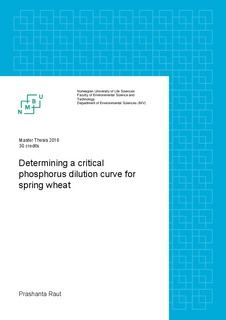| dc.description.abstract | Phosphorus (P) fertilizer is an important input for crop production. Phosphorus deficit limits crop productivity, while excess use creates environmental problems and depletes limited phosphate reserves. Therefore, the use of P fertilizer in agriculture must be optimized to sustain crop production at a desired level, without loading the environment. Values reported in the literature about recommended P concentration for optimal plant growth vary, and precise knowledge of the critical plant P concentration, which is the minimum concentration sufficient for maximum plant growth, is lacking. The critical concentration is expected to decrease with the biomass of the crop, due to dilution of the cytoplasm in the plant, as the share of fibers increases. In order to explore this dilution effect, and tentatively estimate a critical P dilution curve as function of standing biomass, a pot trial was conducted with spring wheat (Triticum aestivum L.). Eight different rates of P fertilizer (0, 1.67, 3.33, 5, 6.67, 10, 20 and 30 mg P/kg soil) were applied to soil with low P content (P-AL 1.6 mg/100g soil). Wheat plants were grown in a growth room at room temperature of 20⁰C, at the rate of 9 plants per 3L pot, under otherwise well fertilized and irrigated condition. Plants were sampled five times from the three leaves stage to nearly maturity. P concentration and shoot biomass was measured at each sampling event. Green area, tillering and several other growth parameters were studied. Shoot biomass increased from lowest to the highest P application rate. Therefore, I was not able to identify the critical plant P concentration. However, my study indicated that P dilution occurs with growth, furthermore the lowest P concentration observed was 0.5 mg P/g DM, which could suggest this is a physiological minimum. The concentrations of P in the flag leaf and in the penultimate leaf were approximately constant, while the leaf area increased with P application. There was no effect of P application on the photosynthesis rate of the flag leaf. This indicates that, at least at the low P supply of this experiment, plant reduce leaf area to maintain a sufficient P concentration for photosynthesis. | nb_NO |
